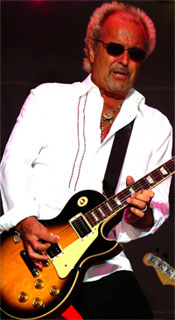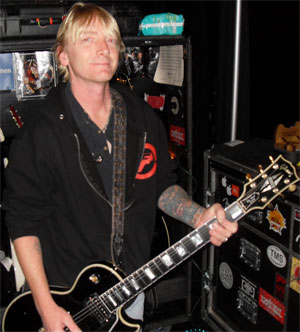HipKitty’s Mick Jones Signature Amp
 Part 2, Protos and Rig Details
Part 2, Protos and Rig Details
Three prototype amps were used by Neal at HipKitty to start the R&D process for Mick’s signature head.
Neal said two 50w heads were started to form the primary distortion channel and tone circuit. The third proto head was/is a 100-watter “that uses the culmination of the refined distortion/tone circuits from the 50-watt proto amps, just adding the 100-watt output, power transformers and circuit.”
On why he started with 50s, Neal said: “I had custom-wound 50w power and output transformers on hand from previous R&D projects, and then kept running with the 50-watters to give Mick an option as the pre-amp/phase inverter section of the circuit was coming together.
“He chose the 100w due to that fact that a 100-watter pushes more air, and the subsequent tonal palette that’s available from the speakers.”
Testing Rig
The testing rig for the Headknocker appears to be a simpler version of Mick’s touring rig – meaning guitar to head to iso cabs. No effects during testing, for obvious reasons.
AJ said that in live performances, Mick uses a Marshall JCM 900-SLX run to two Randall isolation cabinets loaded with Celestion Vintage 30s, one speaker for each iso cab. These are run simultaneously for a left/right mix.
The effects loop of the JCM 900-SLX is run to two separate pedal boards that contain a Boss DD-6 digital delay, a Boss DD-20 Delay, and a TC Electronic Stereo Chorus/Flanger. Both pedal boards have identical effects and settings. One is onstage for Mick’s access and use, and the other one is offstage for AJ.
Here’s AJ on the guitars: “Though he has an array of Les Pauls, Mick likes to pick one and stick with it. He does, however, play his signature model for a specific song or two. Really cool guitar. It has a solid mahogany body, 22-fret ebony fingerboard, pickups are 57’ open-coil. We tour with two of them, the original prototype and the #1. They both look remarkably identical to the original.
“We have a white [Les Paul] Classic on tour, as well as a black ’74 Custom and a couple 1960 reissues. We also carry an early 60’s Gibson J200, a Black (custom color) 2010 Gibson J200 and a Babicz Identity acoustic.â€
Mick’s main guitar of late is his tobacco-burst Les Paul Standard with DiMarzio Super Distortion pickups. AJ says his string gauge is 9, 11, 16, 30, 42 and 52 – Ernie Balls. “Makes for a really nice tone,†he says. I’m sure!
When?
AJ said: “Based on Mick’s guitar tone, we’re very excited about the release of HipKitty’s new amplifier, The Headknocker.”
I’m excited too. I’m a big fan of Mick’s classic Foreigner tone and can’t wait to hear one of these amps in person. So my question to Neal was, When?
He said: “We’re in the finalization stages of The Headknocker, and are looking to have the final version ready for Mick’s touring rig and public availability soon.”
Here’s what we have to look forward to – another iso track (again here with the full blessing of Mick himself):
Double Vision
[audio:/DOUBLEVISION- Main Gtr.mp3]
For updates, stay tuned here or check the HipKitty website.
More: The Name
The Headknocker – that says “loud” to me. Apparently to Foreigner singer Kelly Hansen too, who named it after some proto testing at Foreigner shows. Mick gave the name the thumbs-up, and there you go.
Btw, Kelly sang for Hurricane – remember that band? That guy has some pipes, man, wow.
More: Mick’s Classic Rig
Here’s more from Mick and AJ:
> Mick recalled that most of the guitar tracks were recorded dry, with a few exceptions. No additional EQ was used during the recording process, with mic/speaker placement the key to obtain the preferred tones going to tape. Mick stated that the same theory was applied to compression…let the amp/speaker/console/tape provide the natural compression.
> The speaker cabs were Hiwatt 4x12s loaded with Fane speakers.
> Mick’s guitar used on the first two Foreigner albums was his 1958 Gibson Les Paul Custom that was modified, and his 1957 Gibson Les Paul that saw service on Head Games.
_____
Thanks much to Neal, AJ and Mick for this info!
* End of part 2 of 2 *
1979!
Doesn’t get more ’80s than this! All you need to hear of Mick’s tone happens in the first 10 seconds….
Recent, Jason Bonham on the skins
Category: Boss/Roland, Celestion speakers, HipKitty Products, Les Paul, Marshall, Mick Jones/Foreigner, Randall Amplifiers, TC Electronic















Well my previous comment has not really been addressed: EQ and compression were not used during recording, but still could have been (and probably was) applied at mixdown. Not quite sure if we’re hearing pure amp sound.
Still it’s a damn awesome sounding track and a lesson in how guitar parts should be constructed. Thanks.
Mick said, directly, that the tracks were recorded, mixed and mastered without additionals, with a very few exceptions where a track (or two) went to tape with echo chamber verb and some effects like phase and fuzz. Mick has an incredible ear and knows how to get great sounds the old school ways. That did change as time went on with Foreigner, of course. But the tone and amp drive (distortion)changes on the tracks I was sent we done at the amp, the guitar and with Mick’s playing style. You are hearing the amp, the guitar and the player…and the art of real multi-tracking.